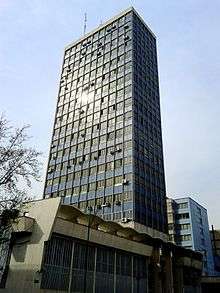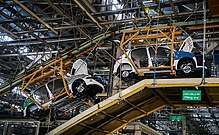Economy of Tehran
Tehran is the capital city and the main economic centre of Iran.[1] Tehran's present-day modern industries include the manufacturing of automobiles, electronics and electrical equipment, weaponry, textiles, sugar, cement, and chemical products. It is also a leading center for the sale of carpets and furniture.[2] The oil refining companies of Pars Oil, Speedy, and Behran are based in Tehran. Tehran hosts 45% of Iran's industries.[3]

Few foreign companies operate in Tehran, due to the government's complex international relations. But prior to the 1979 Revolution, many foreign companies were active in Iran.[4]
Tehran Economy by Sector
Manufacturing and services

At the end of the twentieth century, more than one-third of all jobs in Tehran were related to social and personal services, also about one-fifth were in manufacturing and about one-sixth were in sales. construction, Transport and financial services each employed fewer workforce. Overall, services account for almost two-thirds of the workforce, Also fewer people employed in industrial activities and a negligible amount employed in agriculture.[1]
Manufacturing industries include metal machinery and equipment, textiles, chemicals, wood, mining, paper and basic metals.[1]
Energy
The country's economy is heavily dependent on oil and headquarters of one of the world's largest oil companies NIOC is located in Tehran.[5]
Tourism

Tehran is one of Iran's leading tourism destinations,[7][8] and the city is home to an array of famous tourist attractions. In 2016, Tehran received 1.64 million foreign tourists.[9] There are several artistic, historic and scientific museums in Tehran, including the National Museum of Iran, and the Carpet Museum.
There is also the Museum of Contemporary Art, which hosts works of artists such as Andy Warhol, Pablo Picasso and Van Gogh.[10]
The Iranian Imperial Crown Jewels, are also on display at Tehran's National Jewelry Museum. A number of cultural and trade exhibitions take place in Tehran and many of them are popular events for tourism. Tehran International Book Fair is known to the international publishing world as one of the most important publishing events in Asia. Also, There are many parks and open spaces in the Tehran area. Access to Tehran is provided by Imam Khomeini and Mehrabad airports.[11] Also Tehran offers many forms of public transportation: Tehran Metro, a bus rapid transit system, trolleybuses, and a large network of highways with taxis. Also, There are high-end restaurants and street food on the many streets.
Media
Tehran is home to many international and regional TV and radio stations. The public broadcaster IRIB has its headquarters in Tehran. Also Tehran has Iran's largest number of daily newspapers. The headquarters of most of Iran's global media is located in Tehran.
Creative industries and entertainment
Tehran creative arts sector comprises advertising, architecture, art, design, fashion, film, music, performing arts, publishing, software, TV, radio, and video games. Tehran is main center for Persian language film industry. The city is also home of the Fajr International Film Festival and the Shahr International Film Festival.[12]
Education and research
Tehran is the most prolific centers of higher education and research in the Middle East. The oldest modern university of the city, University of Tehran was established in 1934 and it is one of the most prestigious universities in Asia.[13][14]
Economic History of Tehran
After 1979 Revolution
Prior to the 1979 Revolution, there were many foreign companies and employees in Iran. Companies of Tehran were also more international activities. After the 1979 Revolution, workers, employees, and foreign companies left Iran. With Joint Comprehensive Plan of Action, The economic situation of Tehran's companies has improved.[15]
References
- "Tehrān | national capital, Iran". Encyclopedia Britannica. Retrieved 2018-07-09.
- "Tehran - Economy". en.tehran.ir. Archived from the original on 2018-07-08. Retrieved 2018-07-09.
- Anthony H. Cordesman (September 23, 2008). "The US, Israel, the Arab States and a Nuclear Iran. Part One: Iranian Nuclear Programs" (PDF). Center for Strategic and International Studies. Retrieved September 25, 2010.
- Chaichian, Mohammad (2009). Town and Country in the Middle East: Iran and Egypt in the Transition to Globalization. New York: Lexington Books. pp. 98–103. ISBN 978-0-7391-2677-6.
- "NIOC". NIOC. Retrieved 2019-09-03.
- "برج میلاد، بزرگترين رستوران گردان جهان و شام 168 هزارتومانی". fararu.com. Retrieved 2019-09-03.
- "تهران، مقصدِ گردشگران". شورای اسلامی شهر تهران (in Persian). Retrieved 2018-12-30.
- Dehghan, Saeed Kamali (2013-10-18). "Iran's top 10 tourist destinations – in pictures". The Guardian. ISSN 0261-3077. Retrieved 2018-12-30.
- "تهران میزبان ۱.۶ میلیون گردشگر خارجی". اقتصاد آنلاین (in Persian). Retrieved 2018-12-30.
- "ایران: آثار موزه هنرهای معاصر را به خارج نمیفرستیم". BBC (in Persian). 2017-06-17. Retrieved 2019-01-30.
- "mizanonline". www.mizanonline.com. Retrieved 2019-09-03.
- "آغاز فعالیت هفتمین جشنواره فیلم شهر". ایسنا (in Persian). 2019-07-18. Retrieved 2019-09-03.
- "Tehrān - Administration and social conditions". Encyclopedia Britannica. Retrieved 2019-09-03.
- "آشنایی با دانشگاه تهران". همشهری آنلاین (in Persian). 2008-05-13. Retrieved 2019-09-03.
- "همه قراردادهای ایران با شرکتهای خارجی در ۱۸ ماه اجرای برجام". مشرق نیوز (in Persian). 2017-08-22. Retrieved 2019-09-03.